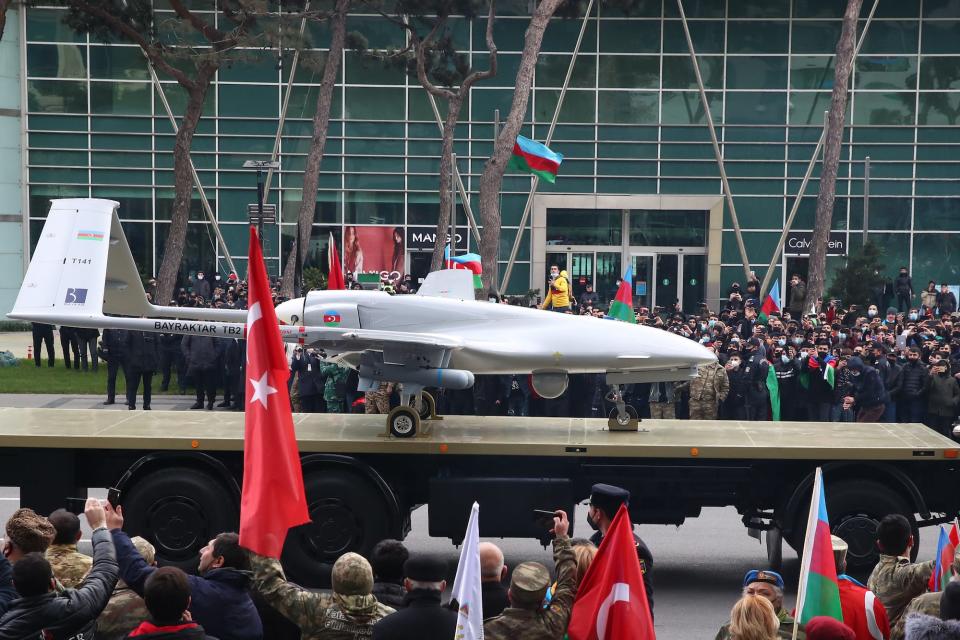Ukraine credits Turkish drones with eviscerating Russian tanks and armor in their first use in a major conflict

Turkish-made Bayraktar drones have taken a prominent role in Ukraine's war effort.
Commanders shared videos showing the TB2 model hitting Russian convoys.
The footage served as a morale boost as Russia continued its campaign.
As Russia pounded Ukraine in the opening days of its invasion, the defenders credited a new piece of equipment with helping them fight back — the Bayraktar TB2 drone.
Videos shared by the Ukrainian military showed at least one strike appearing to tear apart a column of Russian tanks and armored vehicles.
One came from Malyn in the Zhytomyr region, about 150 kilometers from Ukraine's capital, Kyiv, and shows the destruction of a Russian Buk surface-to-air missile launcher, the Ukrainian military said.
—ВОЇНИ УКРАЇНИ🇺🇦 (@ArmedForcesUkr) February 27, 2022
"Bayraktars at work," the caption for the same video posted on an official military Facebook page said. "Be afraid, enemies, there will be no peace for you in our land." The operators can be heard cheering in the video after the strike lands.
Another was from southern Ukraine's Chornobaivka, an area that experienced heavy fighting from Russian forces pouring in via Crimea, which is occupied by Russia.
Footage from the ground appears to show the aftermath, with charred, smoking metal strewed along a highway. The first video below was shared by the Ukrainian Embassy in Turkey and the second by a staffer at the open-source research collective Bellingcat.
—Ukraine in Turkey (@UKRinTR) February 27, 2022
—Christo Grozev (@christogrozev) February 27, 2022
The Russian invasion of Ukraine represents the first outing in a major conflict for the Bayraktar, an armed drone with a 12-meter wingspan and a distinctive triangular tail section.
It is produced by the Turkish weapons manufacturer Baykar, which says the drones can reach altitudes of 25,000 feet and fly for 27 continuous hours, operated remotely from up to 300 km away. Each one can carry up to four laser-guided bombs or rockets, for an estimated total payload of 150 kilograms.
The Bayraktar is showing the effectiveness of small drones like this to unleash havoc on invading columns of vehicles. A US MQ-9 Reaper, by comparison, has a 20-meter wingspan and can carry up to 1,701 kilograms of ordnance.

According to The Wall Street Journal, they can also be a powerful aid to artillery strikes by giving laser-pinpointed coordinates for strikes that would otherwise involve some guesswork.
Ukraine received the drones for the first time in 2019 but didn't use them in combat until last year. Its armed forces published a video of the first time one was used, to destroy a separatist piece of artillery in the Donbas:
The drone quickly acquired celebrated status among Ukrainians as war descended, and videos of its prowess went viral on social media: Insider counted more than 5 million views across various iterations of the above videos between Facebook and Twitter posts.
In a widely shared video of an unnamed Ukrainian soldier mocking the Russians, the drones' power was a key point: "Is everything OK with you, dudes? How do you like our Bayraktars? What do you think — oh, what's that flying over you right now?"
On Telegram, the popular channel run by the Ukrainian parliament shared both Bayraktar strike videos on Sunday, the first of which said, "Let's win together!" and the second of which concluded, "Our army, our power!"
The Ukrainian Embassy in Turkey posted videos of the strikes and their aftermath. According to The Journal, one message in Turkish translated to: "Never a rose without a thorn. Russian invaders have to put up with Bayraktar TB2s."
It said the embassy also called the strikes "divine justice," framing them as revenge for an airstrike in Syria that killed 34 of its troops, for which some have blamed Russia.
Read the original article on Business Insider

